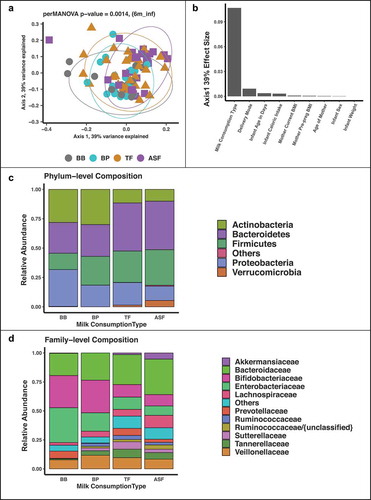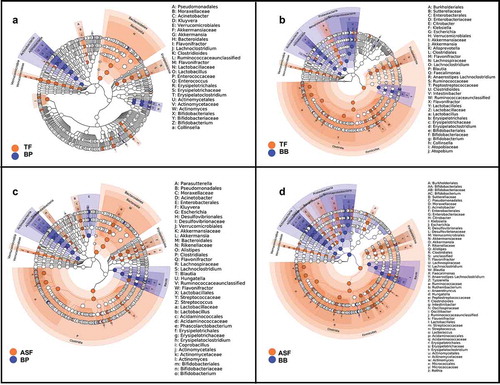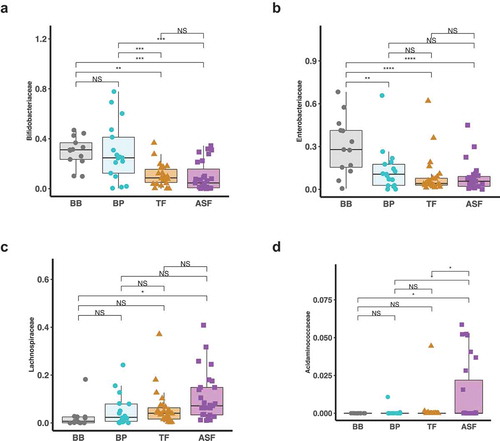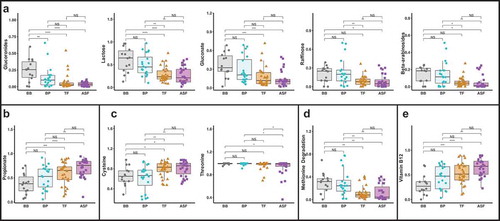Figures & data
Table 1. General characteristics of 6-month old infants by milk consumption.
Figure 1. Multidimensional scaling (MDS) of 16S rRNA gene sequences colored by milk consumption type at 6 months. There is statistically significant separation between formula-fed infants and breastfed infants for both MDS axis 1 and axis 2, p values computed by independent ANOVA tests of each axis (a). Milk consumption type has a larger effect on the first MDS axis than delivery mode and infant weight (b). The phylum Proteobacteria has the highest mean relative abundance in the breast-fed (BB) group while Bacteroidetes has the highest mean relative abundance in the two formula groups (TF and ASF) (c). The family Enterobacteriaceae has the highest mean relative abundance in the BB group while Bacteroidaceae has the highest mean relative abundance in TF and ASF groups (d).

Table 2. Average diversity across milk consumption type.
Figure 2. Linear discriminant analysis shows the microbial taxonomic groups that are enriched and depleted in infants consuming formula versus infants whose sole milk source is human milk. When comparing the gut microbiome of infants in the who consume expressed human milk in a bottle (BP) to infants who consume traditional formula (TF) (a), differences are apparent, but more differences result from the comparison of the gut microbiomes of infants whose only source of milk is through breastfeeding (BB) to those in the TF group (b). Even more microbes are revealed to be discriminant when we compare BP group and group consuming lactose-reduced formula with added-sugar (ASF) (c) and the BB group and ASF (d).

Figure 3. Log-normalized relative abundances of taxonomic families that are significantly different among the milk consumption types. At 6 months, microbes belonging to Bifidobacteriaceae are enriched in breastfed infants compared to formula fed infants with the infants who consume lactose-reduced formula with added corn syrup solids (ASF) having the lowest abundance (a). Enterobacteriaceae was also enriched in breastfed infants compared to formula fed infants but it was also significantly lower in the group who consume some human milk from a bottle (b). Further, microbes belonging to the families Lachnospiraceae are enriched in formula fed infants compared to breastfed infants with the infants in the ASF group having the highest abundance (c). Acidaminococcaceae was significantly higher in the infants who consume lactose-reduced formula with added corn syrup solids (ASF) (d).

Table 3. Taxonomic families determined to be significantly different among milk consumption type groups.
Table 4. Predicted community metabolic phenotypes determined to be significantly different among milk consumption type groups.
Figure 4. CPIs of predicted functions that are significantly different among the four milk consumption types. Gut microbial profiles derived from 16S rRNA sequencing of stool samples from 6 month old infants were used to predict functional phenotypes of the gut microbes. There were significant differences in carbohydrate utilization (a), short-chain fatty acid (SCFA) production (b), amino acid biosynthesis and degradation (C and D) and vitamin biosynthesis (e).

